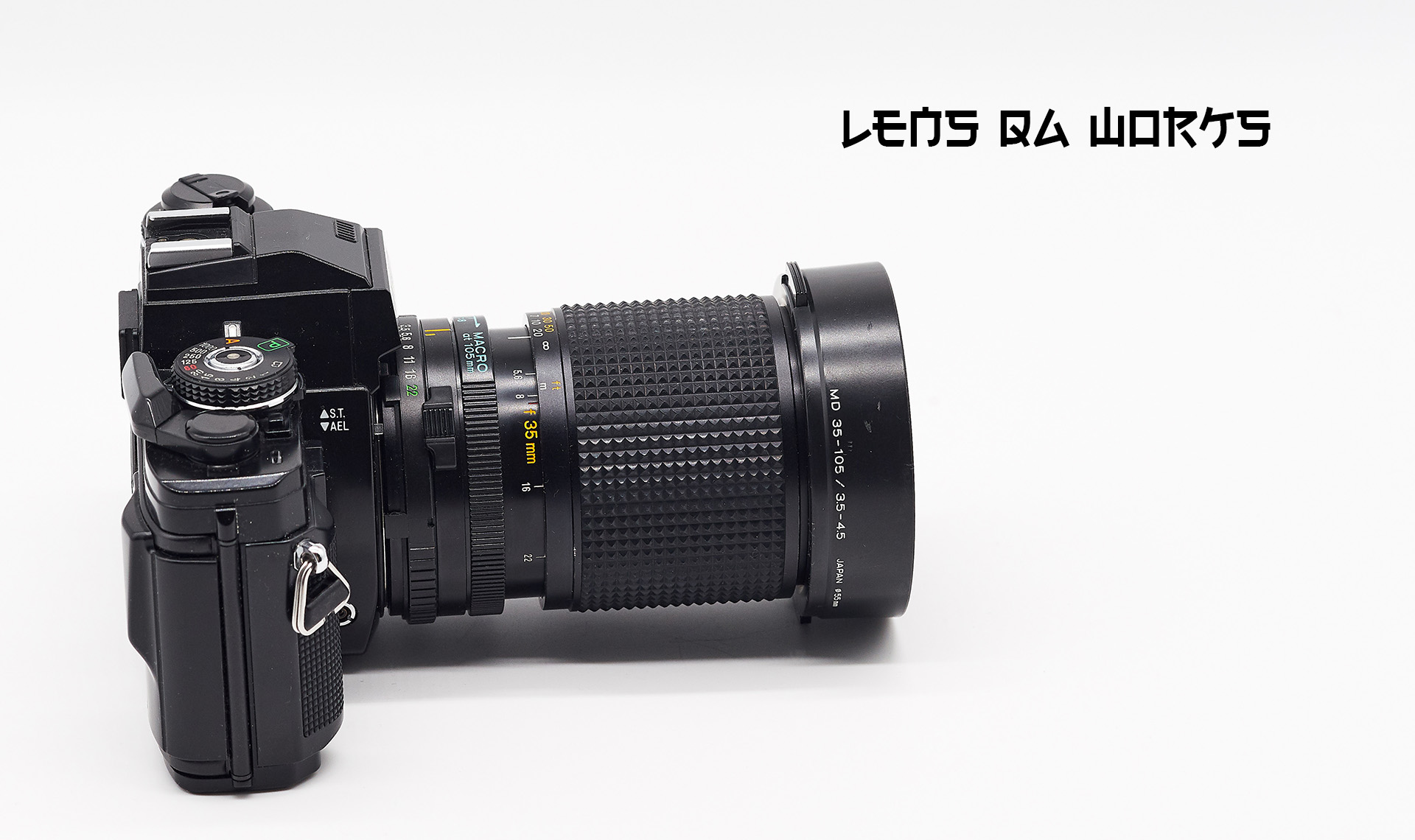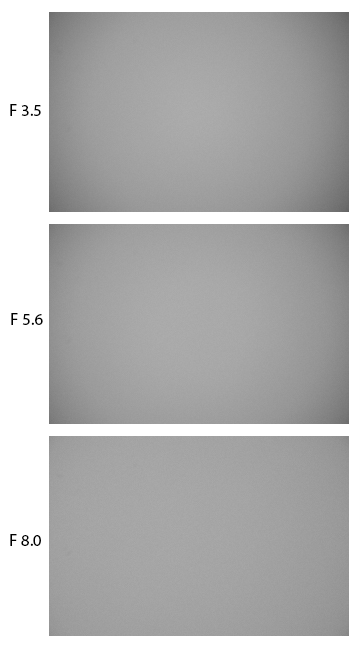Minolta MD 35-105mm 1:3.5-4.5 Zoom Macro – 14 elements 12 groups – review

Minolta MD 35-105mm 1:3.5-4.5 Zoom 14el 12gr Macro lens review
- Official classification: New-MD
- Collector’s classification: MD III
Almost 3-x zoom with convenient focal distances from enough wide to enough telephoto. The candidate to be the only one lens in a photographer’s bag but… Tests below show that the lens has not enough power to become a favorite. In other words – it’s a really good lens, but not ideal. Such a case often happens with middle-range zooms, even more – this Minolta is not bad by IQ among other lenses with the same diapason.
Tests for this review are divided for 35mm, 50mm, 70mm, 105mm groups.
Minolta MD 35-105mm 1:3.5-4.5 Zoom 14el 12gr specifications
| # in minolta.eazypix.de index | 262 |
| Name engraved on the lens | MD ZOOM |
| f[mm] | 35-105 |
| A max [1/f] | 3.5-4.5 |
| A min[1/f] | 22 |
| Lens design [el.] | 14 |
| Lens design [gr.] | 12 |
| Filter thread Ø front(rear)[mm] | 55 |
| Lens Shade | clip-in |
| closefocus[m/ft] | 1.5/5 |
| Dimension Ø x length [mm] | 64×88 |
| Weight[g] | 430 |
| Year | 1983 |
| Style | MD III |
| Code No. (ROKKOR-X) or Order No. | 2525-110 |
| Notes | 2-Touch w/ macro mode at 105mm |
| Floating elements | YES |
| Aperture blades number | 7 |
| Confidence in the test results of reviewed copies | Enough high |
| Reviewed Lens SN: | 1019305 |
Minolta produced two different 35-105mm lenses, both in New-MD generation. This article is about the later modification: 14 elements in 12 groups and with the minimal focus distance 1.5m. Macro mode is available at 105mm only. The production was started in 1983.
The previous one is from 1981, 16el.-13gr., 1.6m close focus, and Macro available over the whole diapason.
Minolta MD 35-105mm 1:3.5-4.5 Zoom 14el 12gr lens exterior
Mounted on Minolta X-700
Original lens-shade (lens-hood)
Minolta MD 35-105mm 1:3.5-4.5 Zoom 14el 12gr sharpness
Сlose-distance resolution test, minimal distance
Testing methods description
- Target: 10-15 cm picture, printed on glossy photo paper
- Distance: 1.7m
- Camera: Sony A7II (24mpx, full-frame, tripod, remote control). M-mode, ISO fixed, WB fixed, SteadyShot – OFF.
- The test was repeated for every F-stop on every focus position with manual focus adjustment for each shot. That is to avoid the effect of field curvature.
- RAW processing: Capture One, default settings. All quality settings – 100%. Crops – 300×200 px
Original target image (printed in horizontal orientation on 10cm X 15cm glossy photo paper
Long-distance resolution test
Testing methods description
- Target: cityscape
- Distance: > 200 meters to center focus point
- Camera: Sony A7II (24mpx, full-frame, tripod, remote control). M-mode, ISO fixed, WB fixed, SteadyShot – OFF. The focus point is on the center only.
- RAW processing: Capture One, default settings. All quality settings – 100%. Crops – 300×200 px
Minolta MD 35-105mm 1:3.5-4.5 Zoom 14el 12gr TEST RESULTS on FOCUS DISTANCE = 35mm
35mm – Sharpness – a short distance
35mm – Scene preview
35mm – Test results
35mm – Sharpness – long distance
35mm – Scene preview
35mm – Test results
35mm – Vignetting
35mm – Geometric distortion
35mm – Coma aberrations
35mm – Chromatic aberrations
35mm – Long-distance bokeh
Test#1
Test conditions: lens was focused on minimal distance 1.2m, houses were fixed in infinity distance on the ground.
35mm – Light bubbles long-distance bokeh
Test conditions: lens was focused on minimal distance 1.2m, lights were fixed in more than 200m
Minolta MD 35-105mm 1:3.5-4.5 Zoom 14el 12gr TEST RESULTS on FOCUS DISTANCE = 50mm
50mm – Sharpness – a short distance
50mm – Scene preview
50mm – Test results
50mm – Sharpness – long distance
50mm – Scene preview
50mm – Test results
50mm – Vignetting
50mm – Geometric distortion
50mm – Coma aberrations
50mm – Chromatic aberrations
50mm – Long-distance bokeh
Test conditions: lens was focused on minimal distance 1.2m, houses were fixed in infinity distance on the ground.
50mm – Light bubbles long-distance bokeh
Test conditions: lens was focused on minimal distance 1.2m, lights were fixed in more than 200m
Minolta MD 35-105mm 1:3.5-4.5 Zoom 14el 12gr TEST RESULTS on FOCUS DISTANCE = 70mm
70mm – Sharpness – a short distance
70mm – Scene preview
70mm – Test results
70mm – Sharpness – long distance
70mm – Scene preview
70mm – Test results
70mm – Vignetting
70mm – Geometric distortion
70mm – Coma aberrations
70mm – Chromatic aberrations
70mm – Long-distance bokeh
Test conditions: lens was focused on minimal distance 1.2m, houses were fixed in infinity distance on the ground.
70mm – Light bubbles long-distance bokeh
Test conditions: lens was focused on minimal distance 1.2m, lights were fixed in more than 200m
Minolta MD 35-105mm 1:3.5-4.5 Zoom 14el 12gr TEST RESULTS on FOCUS DISTANCE = 105mm
105mm – Sharpness – a short distance
105mm – Scene preview
105mm – Test results
105mm – Sharpness – long distance
105mm – Scene preview
105mm – Test results
105mm – Vignetting
105mm – Geometric distortion
105mm – Coma aberrations
105mm – Chromatic aberrations
105mm – Long-distance bokeh
Test conditions: lens was focused on minimal distance 1.2m, houses were fixed in infinity distance on the ground.
105mm – Light bubbles long-distance bokeh
Test conditions: lens was focused on minimal distance 1.2m, lights were fixed in more than 200m
Minolta MD 35-105mm 1:3.5-4.5 Zoom 14el 12gr final conclusion
This is just enough fast and compact normal zoom with comfortable focal lengths. To the list of good things, I have to add good results of coma and vignetting tests. That’s the end of the positive from my point of view.
We can easily see the lack of sharpness not only at corners but in middle positions too. Even the closing of the aperture to F8-F11 is not enough for good corners. There is nothing that is able to compensate so noticeable problems with sharpness. Add here the also noticeable geometric distortion at all distances except 35mm.
One-touch design is not a good feature too, for me personally at least. In those days it was popular, I don’t know why. And of course, the label “Macro” is about marketing, not about a macro.
Yes, this lens is very good for manual 3x-zoom. Usually, I avoid to compare the lenses in conclusions after reviews, but here I want to say that this lens has a very similar IQ with MD 35-135/3.5-4.5 but a little shorter.
On the other hand – a lot of people are happy with this lens and if you caught it then use it. As I said already – there are no many zooms with this diapason of focal distances, and this Minolta is really a nice tool if to compare with others.




































































6 Comments
Egor · 2019-12-18 at 16:45
OMG! Very strange, especially considering the fact that longer (!) MD 35-135 is a great lens!
Tony · 2019-12-18 at 20:39
I’ve tested 35-135 and both lenses – I mean 35-105(14L) and 35-135 show enough the same IQ
roseblood11 · 2019-12-18 at 19:12
Other tests of this lens were quite positive and the early AF version with identical optical formula is a well-regarded lens, too.
I own a copy of this lens that looks like new, but it can’t focus to infinity.
It’s obviously damaged, and I think that your copy is damaged, too. It’s a quite sure indicator, that your copy doesn’t reach good sharpness at all apertures even in the center.
I have seen many photographs that were shot with this lens that were just as good as the 3.5/35-70 macro.
Tony · 2019-12-18 at 20:37
I think that I can justifiably doubt in your words, sorry. Definitely, this lens can’t be as good as 35-70/3.5 macro, and secondly – tests from other reviewers confirm the results. The problem is just because I expected a performance better than 35-135/3.5-4.5 – which is actually not a champion, but both of them works just the same way
Stefan · 2022-07-03 at 16:56
I checked the the 35-135 review as well, which is quite positive. This one comes to quite a negative conclusion, but at the same time the lens has been described as equal to 35-135. Isn’t it a bit contradictory? Anyway, always a pleasure to check this website, thanks for the great work.
Tony · 2022-07-03 at 18:12
Hi Stefan, I agree with your comment. And if we add to the discussion 35-105 with the formula 16×13, then the situation with the conclusions will become even more complicated. Because it so happened that each of these lenses is bad in its own way, but at the same time each one is good in its own way.
When writing reviews, I try to avoid comparisons between lenses. To do this, I do special “battles”, where I study lens tests in comparison by frame positions.
As for this trio – 35-105 16×13, 35-105 14×12 and 35-135, it is objectively impossible to choose the best one – someone needs 135mm more than corners on a wide one, someone needs compactness, etc. As for 35-135, this is a 4x zoom. And the fact that it turned out to be better than smaller zooms in some ways makes it a bit wonderful. But at the same time, shorter zooms differ quite noticeably from each other, winning and losing each other in different indicators.
As far as listing IQs as more or less the same, it refers to the fact that if I were to create charts(/scores), both lenses would score roughly the same, just each for different reasons
(I will add review for 35-105 16×13 soon)